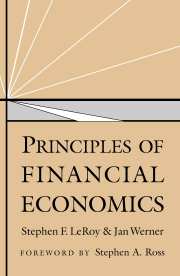Book contents
- Frontmatter
- Contents
- Foreword
- Preface
- Part One Equilibrium and Arbitrage
- Part Two Valuation
- Part Three Risk
- Part Four Optimal Portfolios
- Part Five Equilibrium Prices and Allocations
- Part Six Mean-Variance Analysis
- Part Seven Multidate Security Markets
- 21 Equilibrium in Multidate Security Markets
- 22 Multidate Arbitrage and Positivity
- 23 Dynamically Complete Markets
- 24 Valuation
- Part Eight Martingale Property of Security Prices
- Index
23 - Dynamically Complete Markets
Published online by Cambridge University Press: 05 September 2012
- Frontmatter
- Contents
- Foreword
- Preface
- Part One Equilibrium and Arbitrage
- Part Two Valuation
- Part Three Risk
- Part Four Optimal Portfolios
- Part Five Equilibrium Prices and Allocations
- Part Six Mean-Variance Analysis
- Part Seven Multidate Security Markets
- 21 Equilibrium in Multidate Security Markets
- 22 Multidate Arbitrage and Positivity
- 23 Dynamically Complete Markets
- 24 Valuation
- Part Eight Martingale Property of Security Prices
- Index
Summary
Introduction
As defined in Chapter 21, security markets are dynamically complete (at prices p) if any consumption plan for future dates can be obtained as a payoff of a portfolio strategy; that is, if M(p)=Rk. Security markets are incomplete if M(p) is a proper subspace of Rk.
In the two-date model of Chapter 1, completeness of security markets requires the existence of at least as many securities as states. In the multidate model the opportunity to trade securities at future dates implies that many fewer securities than events are necessary for markets to be dynamically complete.
In this chapter we provide a characterization of dynamically complete security markets and show that, for such markets, equilibrium consumption allocations are Pareto optimal.
Dynamically Complete Markets
An example of securities that result in markets that are dynamically complete at arbitrary prices are the Arrow securities. The Arrow security for event ξt has a dividend of one in event ξt at date t and zero in all other events and at all other dates. If all k Arrow securities are traded, then any consumption plan in Rk can be generated using a buy-and-hold portfolio strategy.
With Arrow securities, markets are dynamically complete even if trading is limited to date 0. As noted in Section 23.1, the opportunity to trade at future dates significantly reduces the number of securities needed for dynamically complete markets.
- Type
- Chapter
- Information
- Principles of Financial Economics , pp. 233 - 240Publisher: Cambridge University PressPrint publication year: 2000

